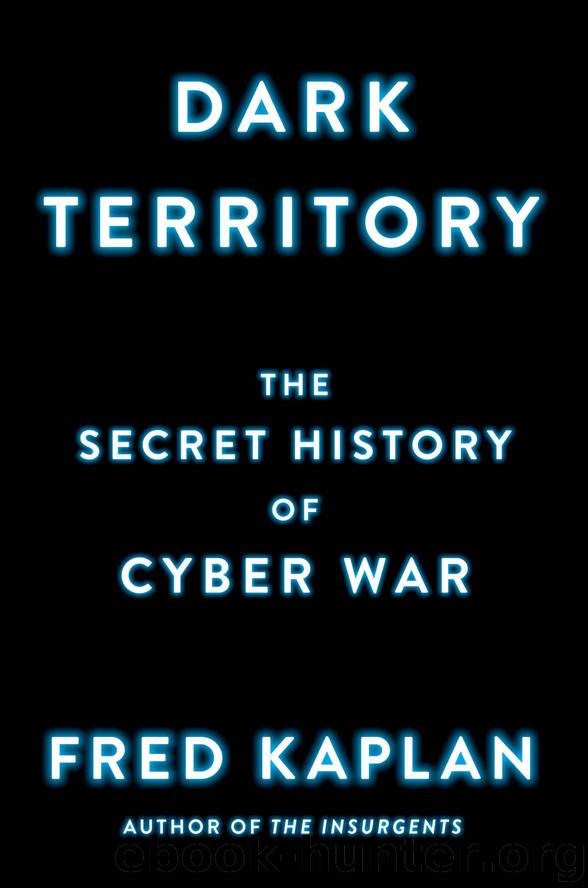Dark Territory: The Secret History of Cyber War by Fred Kaplan

Author:Fred Kaplan [Kaplan, Fred]
Language: eng
Format: azw3
Publisher: Simon & Schuster
Published: 2016-03-01T05:00:00+00:00
* * *
The pivotal moment in this shift occurred at NSA headquarters on Friday, October 24, 2008. At two-thirty that afternoon, a team of SIGINT analysts noticed something strange going on in the networks of U.S. Central Command, the headquarters running the wars in Afghanistan and Iraq.
A beacon was emitting a signal, and it seemed to be coming from inside CentCom’s classified computers. This was not only strange, it was supposedly impossible: the military’s classified networks weren’t connected to the public Internet; the two were separated by an “air gap,” which, everyone said, couldn’t be crossed by the wiliest hacker. And yet, somehow, someone had made the leap and injected a few lines of malicious code—that was the only plausible source of the beacon—into one of the military’s most secure lines of communication.
It was the first time ever, as far as anyone knew, that a classified network of the Department of Defense had been hacked.
The intrusion might not have been spotted, except that, a year earlier, when cyber war took off as a worldwide phenomenon, Richard Schaeffer, head of the NSA’s Information Assurance Directorate—whose staff spent their workdays mulling and testing new ways that an outsider might breach its defenses—dreamed up a new tangent. Over the previous decade, the military services and the various joint task forces had done a reasonably good job of protecting the perimeters of their networks. But what if they’d missed something and an adversary was already inside, burrowing, undetected, through thousands or millions of files, copying or corrupting their contents?
Schaeffer assigned his Red Team—the same unit that had run the Eligible Receiver exercise back in 1997—to scan the classified networks. This team discovered the beacon. It was attached to a worm that they’d seen a couple years earlier under the rubric agent.btz. It was an elegant device: after penetrating the network and scooping up data, the beacon was programmed to carry it all home. The Office of Tailored Access Operations, the NSA’s cyber black-bag shop, had long ago devised a similar tool.
Schaeffer brought the news to Alexander. Within five minutes, the two men and their staffs came up with a solution. The beacon was programmed to go home; so, they said, let’s get inside the beacon and reroute it to a different home—specifically, an NSA storage bin. The idea seemed promising. Alexander put his technical teams on the task. Within a few hours, they figured out how to design the software. By the following morning, they’d created the program. Then they tested it on a computer at Fort Meade, first injecting the agent.btz worm, then zapping it with the rerouting instruction. The test was a success.
It was two-thirty, Saturday afternoon. In just twenty-four hours, the NSA had invented, built, and verified a solution. They called the operation Buckshot Yankee.
Meanwhile, the analytical branches of the agency were tracing the worm’s pathways back to its starting point. They speculated that a U.S. serviceman or woman in Afghanistan had bought a malware-infected thumb drive and inserted it into a secure computer.
Download
This site does not store any files on its server. We only index and link to content provided by other sites. Please contact the content providers to delete copyright contents if any and email us, we'll remove relevant links or contents immediately.
| Automotive | Engineering |
| Transportation |
Whiskies Galore by Ian Buxton(41718)
Introduction to Aircraft Design (Cambridge Aerospace Series) by John P. Fielding(33016)
Small Unmanned Fixed-wing Aircraft Design by Andrew J. Keane Andras Sobester James P. Scanlan & András Sóbester & James P. Scanlan(32684)
Craft Beer for the Homebrewer by Michael Agnew(18081)
Turbulence by E. J. Noyes(7893)
The Complete Stick Figure Physics Tutorials by Allen Sarah(7264)
Kaplan MCAT General Chemistry Review by Kaplan(6822)
The Thirst by Nesbo Jo(6756)
Bad Blood by John Carreyrou(6476)
Modelling of Convective Heat and Mass Transfer in Rotating Flows by Igor V. Shevchuk(6353)
Learning SQL by Alan Beaulieu(6158)
Weapons of Math Destruction by Cathy O'Neil(6084)
Man-made Catastrophes and Risk Information Concealment by Dmitry Chernov & Didier Sornette(5877)
Digital Minimalism by Cal Newport;(5585)
Life 3.0: Being Human in the Age of Artificial Intelligence by Tegmark Max(5403)
iGen by Jean M. Twenge(5321)
Secrets of Antigravity Propulsion: Tesla, UFOs, and Classified Aerospace Technology by Ph.D. Paul A. Laviolette(5237)
Design of Trajectory Optimization Approach for Space Maneuver Vehicle Skip Entry Problems by Runqi Chai & Al Savvaris & Antonios Tsourdos & Senchun Chai(4956)
Electronic Devices & Circuits by Jacob Millman & Christos C. Halkias(4864)
